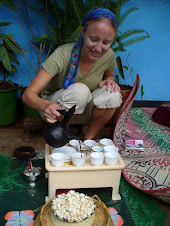It was about a month ago that an unexpected visitor appeared on my doorstep. I was just sitting down to quiet Saturday morning breakfast when I heard a knock on my front door. Somewhat reluctantly tearing myself away from a stack of warm banana pancakes and the latest Sports Illustrated Magazine sent from my mother (a promising start to any morning, to be sure), I answered the door to find a small, weathered Ethiopian man, clutching a red plastic photo album.
"Miss Christen Marie," he said, though I had never before seen him, "I am Negalign Emere, and I have a message from A___ Andersen."
Neither of these two unfamiliar names shedding any light upon the situation, mystified by this visitor and wondering what message he could possibly be bringing, I invited the old man into my living room. He removed his white baseball cap as he entered the house, revealing a head flecked thoroughly with grey. He grasped my hand between both of his in a warm handshake, and his wizened face broke into a wide smile. His eyes were only barely visible as two small eddies amidst the rippling currents of wrinkles surrounding and threatening to inundate them at any moment. He stood and grinned, shaking my hand eagerly, and burst forth with his story before we even had a chance to sit.
He explained that he had been taught by a Peace Corps volunteer in the 1960s, whose name was A___ Andersen. Mr. Andersen had been a science teacher at the secondary school. Negalign had been a struggling fourteen-year-old student who solicited help from Mr. Andersen. Through the hours they spent together in private lessons, Negalign passed his classes with high marks, and so inspired was he by Mr. Andersen's example that he went on to become a science teacher himself. When Mr. Andersen returned to his school many years later to bring a donation of books for the library, Negalign contacted him, and the two reunited to begin a correspondence that continues to this day.
As he told his story, finally sitting down at my insistence, Negalign paged through the worn plastic photo album to show me pictures that had been sent from A___ Andersen along with his letters. I saw Mr. Andersen, his wife, and his five granddaughters. I read the card he had sent for Christmas. I heard stories about his former life in Debremarkos and his current life in
My enthusiastic visitor made good on his promise this week, and KB and I arrived this morning at the arranged time at Debremarkos' oldest secondary school. (I had been told by Negalign on the phone, "Do not be late.") Negalign had given his morning classes to a substitute teacher so that he could devote his full time and attention to serving as our guide. We embarked upon what was presented to us as a tour of need. We met the school principal, who told us of the 65-year-old school's crumbling structure and great need for basic furnishings. He lamented that all work had to be completed tediously by hand, without the benefit of photocopiers or typewriters (and certainly no computers). We toured the school's science lab, which housed rows of bare countertop, a set of five instructional anatomy charts, yellowed with age, and one faucet with no running water. We met the chemistry teacher, who bemoaned the lack of basic chemicals needed to perform demonstrational experiments. We observed an English class in which each textbook was shared between at least five students. As Negalign whisked us from building to building with astounding energy, he pointed out broken windows, mud floors, crumbling plaster, and overcrowded benches and desks. Along the way, we learned that there was no formal health education integrated into the curriculum. At various classroom stops, we were asked to do some impromptu Q-and-A with the students about HIV/AIDS. We received wonderfully insightful questions that showed, encouragingly, a good deal of background knowledge about the pandemic, while also revealing a number of informational gaps. (At this point, I must add: There are a host of specific regulations imposed by American funding agencies in regard to the ages at which students may and may not be taught about condom use. These become rather impractical when one finds oneself suddenly standing in front of a sixth-grade classroom filled with students ranging in age from twelve to twenty.)
Finally, we were introduced to the special needs classes. Two classrooms held a mixture of students, deaf, blind, and intellectually disabled. (We cringed as we were introduced to this last class with a rather more insensitive term. I suppose sensitivity, though, is difficult to translate across languages.) Clusters of students sat together by age and special learning need, as an overworked and undermanned teaching staff made the rounds between them, trying to give sufficient attention to each group. As we introduced ourselves to the blind students, they eagerly punched out the spellings of our names with the Braille styluses they shared. I watched in fascination as the deaf education teacher ran through flashcard vocabulary exercises with her students, signing each word in American sign language and spelling each in both American and Amharic sign spellings. I received sweet smiles of encouragement from the little girls in lemon yellow dresses sitting beside me on the bench, as I fumbled my way through the signs that they produced so effortlessly.
What was framed as a tour of need certainly proved to be so. Yet, it also revealed to us a great deal of hope in the astute questions, demonstrated efforts, and smiling faces of students eager to pave the way to a brighter future through education, as well as the resolve of the teachers determined to help them.

1 comment:
Have u try the CHEMISTRY online bookstore Cocomartini
http://www.cocomartini.com/
I get all my textbooks for this semester from this bookstore. All are brand new and half price discount.
Good luck and wish some help.
hehe ^_^
Post a Comment